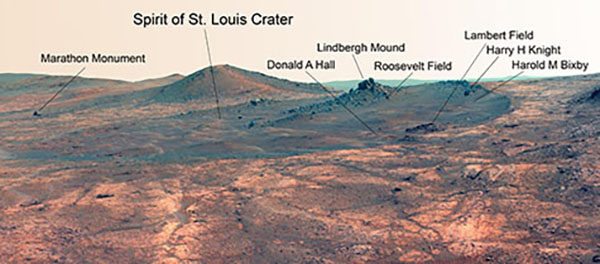
NASA’s Mars Exploration Rover Opportunity is exploring a Martian crater named the Spirit of St. Louis, after the aircraft that made the first solo nonstop flight across the Atlantic. The science team for the rover picks crater names from a list of “vessels of exploration,” including ships of sail and spacecraft as well as aircraft. As long as the rover remains in the crater, names for interesting features will drawn from a list of names related to this famous flight.
Just before it reached the crater, Opportunity completed a marathon (26-plus miles) on Mars and the team picked a distinctive outcrop, Marathon Monument, to mark the finish line. The marathon, in turn, is named after the fabled run of the Greek soldier Pheidippides to relay the news of a victory at the Battle of Marathon. After the rover leaves the crater it will enter Marathon Valley, where orbital data show clay minerals (probably formed on a wetter Mars) are exposed.
Because team members Ray Arvidson and his student Valerie Fox from Washington University in St. Louis found the clay-rich target, the mission team decided to pick the Spirit of St. Louis theme for the crater.
Arvidson, PhD, is deputy prinicpal investigator for the mission and the James S. McDonnell Distinguished University Professor in Arts & Sciences at Washington University.
What’s the connection between St. Louis and the Spirit of St. Louis? Lindbergh flew from New York to Paris, but he named his aircraft for the St. Louis citizens who purchased it for him.
NASA’s Jet Propulsion Laboratory in Pasadena, Calif., manages the Opportunity mission for NASA’s Science Mission Directorate in Washington, D.C.